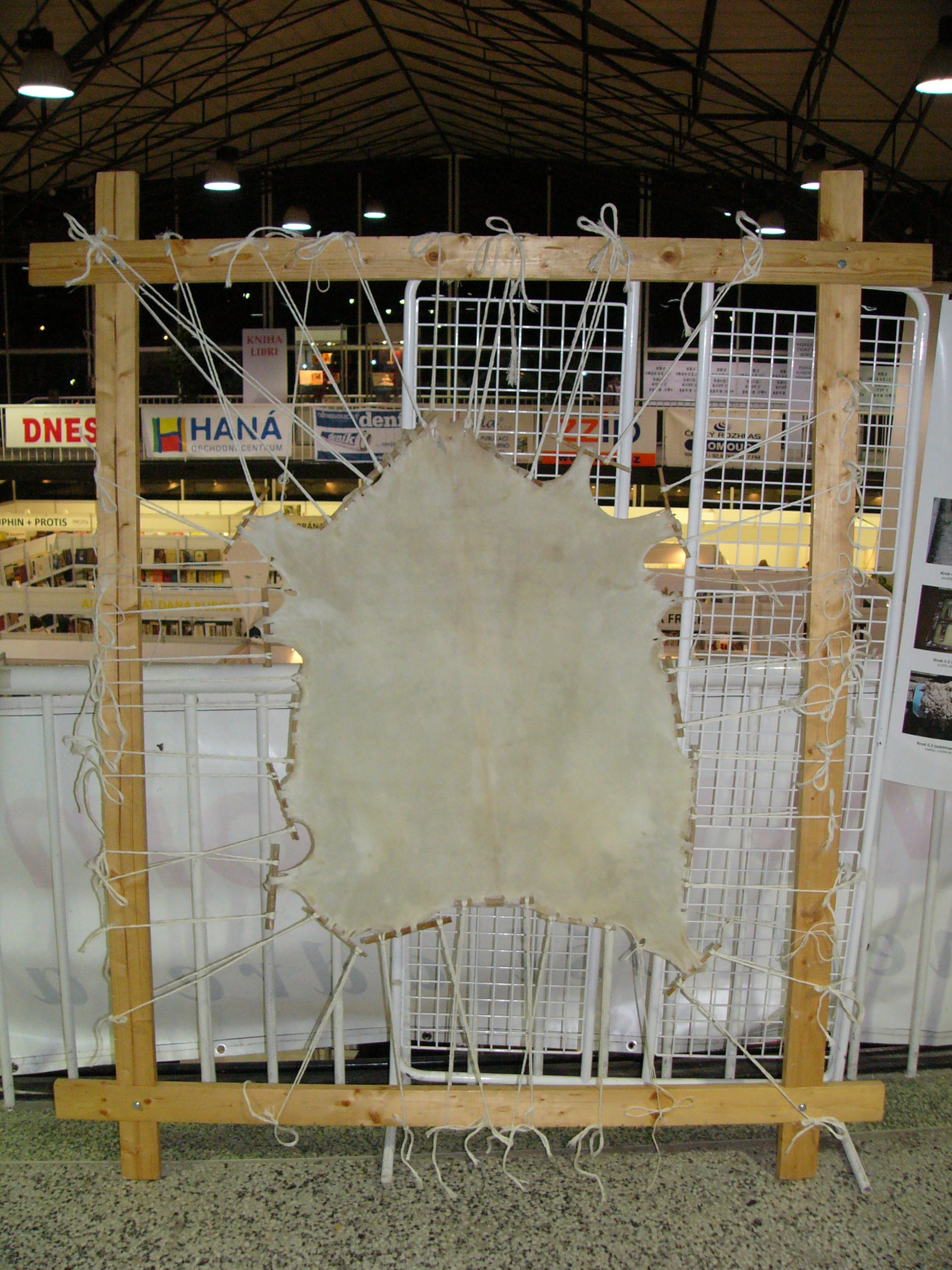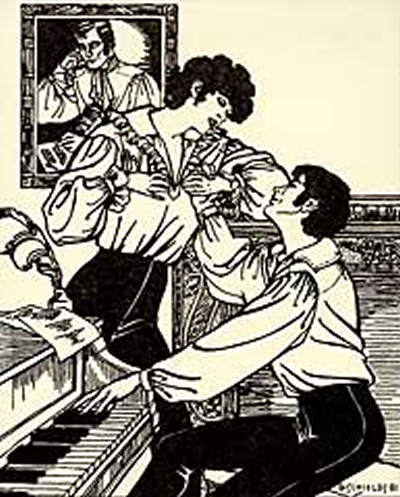|
Organdy
Organdy, also spelled Organdie, is a kind of fabric. It is a lightweight, balanced plain weave made of cotton with features of sheerness and crispness. Characteristics Organdy is a stiffened material; sheerest among its peers, which include lawn cloth and Batiste. Often, these materials may come from the same grey goods, and are differentiated from each other in how they are finished. Organdy's sheerness and crispness are attributed to the acid finish (parchmentising) whereas the lawn cloth is finished with starch or resin, and Batiste is a softer fabric type. Finer yarns with higher twist counts are used in superior quality organdy. Process Organdy is an acid stiffened cloth. Its sheerness and crispness is the result of an acid finish, where the fabric is treated with sulfuric acid solution for a short period and then neutralized to remove excessive acid in a process called " parchmentisation". The parchmentisation is a treatment of acid on cellulosic textiles in the pursu ... [...More Info...] [...Related Items...] OR: [Wikipedia] [Google] [Baidu] |
Parchmentising
Parchmentising or parchmentizing is a kind of aesthetic finish for textiles. It is a finishing treatment for cellulose fabric that stiffens the fabric and imparts a degree of translucency. Parchment Parchment was a material for writing created in ancient times. It was created with animal skin. It means "stuff from Pergamos" in both the Latin and Greek language. Eumenes II developed parchment when papyrus was banned for export to Pergamos by Ptolemy V Epiphanes. The skin of sheep, goats, or cattle was used to create parchment. The parchmentising process involves the application of sulfuric acid to cellulosic textiles in order to achieve the characteristics of parchment. Organdy Parchmentising offers a stiffened and somewhat translucent finish. Organdy is one of the sheerest cloths produced by the process. Development Parchmentising was described in 1850 by John Mercer, who treated cotton with solutions of 110–125 °Tw sulfuric acid, at room temperature, followed by was ... [...More Info...] [...Related Items...] OR: [Wikipedia] [Google] [Baidu] |
Organza
Organza is a thin, plain weave, sheer fabric traditionally made from silk. Many modern organzas are woven with synthetic filament fibers such as polyester or nylon. Silk organza is woven by a number of mills along the Yangtze River and in the province of Zhejiang in China. A coarser silk organza is woven in the Bangalore area of India. Deluxe silk organzas are woven in France and Italy. Organza is distinguished by its crisp hand, stiffness relative to weight, and slippery surface texture. The term may derive from French ''organsin'', ultimately from the Central Asian city of Urgench, the midpoint of the Northern Silk Road. See also * Gauze Gauze is a thin, translucent Textile, fabric with a wikt:loose, loose open Weaving, weave. In technical terms, "gauze" is a weave structure in which the weft yarns are arranged in pairs and are crossed before and after each Warp (weaving), w ... * Organdy * Tulle (netting), another type of sheer fabric References External links ... [...More Info...] [...Related Items...] OR: [Wikipedia] [Google] [Baidu] |
Parchment
Parchment is a writing material made from specially prepared Tanning (leather), untanned skins of animals—primarily sheep, calves and goats. It has been used as a writing medium in West Asia and Europe for more than two millennia. By AD 400 most literature in these regions that was intended for preservation began to be transferred from papyrus to parchment. ''Vellum'' is a finer-quality parchment made from the skins of young animals such as lambs and young calves. The generic term ''animal membrane'' is sometimes used by libraries and museums that wish to avoid distinguishing between parchment and vellum. Parchment and vellum Today the term ''parchment'' is often used in non-technical contexts to refer to any animal skin, particularly goat, sheep or cow, that has been scraped or dried under tension. The term originally referred only to the skin of sheep and, occasionally, goats. The equivalent material made from calfskin, which was of finer quality, was known as ''vellum'' ... [...More Info...] [...Related Items...] OR: [Wikipedia] [Google] [Baidu] |
Marc Jacobs
Marc Jacobs (born April 9, 1963) is an American fashion designer. He is the head designer for his own fashion label, Marc Jacobs, and formerly Marc by Marc Jacobs, a diffusion line, which was produced for approximately 15 years, before it was discontinued after the 2015 fall/winter collection. At its peak, it had over 200 retail stores in 80 countries. He was the creative director of the French design house Louis Vuitton from 1997 to 2014. Jacobs was on ''Time (magazine), Time'' magazine's "2010 Time 100" list of the 100 most influential people in the world, and was #14 on ''Out (magazine), Out'' magazine's 2012 list of ''"''50 Most Powerful Gay Men and Women in America''"''. He married his longtime partner Charly Defrancesco on April 6, 2019. Early life and education Jacobs was born to a Jewish secularism, secular Jewish family in New York City. When he was six, his father, an agent at the William Morris Agency, died. His mother, who remarried three times, was, according to Jac ... [...More Info...] [...Related Items...] OR: [Wikipedia] [Google] [Baidu] |
Haute Couture
(; ; French for 'high sewing', 'high dressmaking') is the creation of exclusive custom-fitted high-end fashion design. The term ''haute couture'' generally refers to a specific type of upper garment common in Europe during the 16th to the 18th century, or to the upper portion of a modern dress to distinguish it from the skirt and sleeves. Beginning in the mid-nineteenth century, Paris became the centre of a growing industry that focused on making outfits from high-quality, expensive, often unusual fabric and sewn with extreme attention to detail and finished by the most experienced and capable of sewers—often using time-consuming, hand-executed techniques. ''Couture'' translates literally from French as "dressmaking", sewing, or needlework and is also used as a common abbreviation of ''haute couture'' and can often refer to the same thing in spirit. Terminology In France, the term ''haute couture'' is protected by law and is defined by the '' Paris Chamber of Commerce ... [...More Info...] [...Related Items...] OR: [Wikipedia] [Google] [Baidu] |
Lining (sewing)
In sewing and tailoring, a lining is an inner layer of fabric, fur, or other material inserted into clothing, hats, luggage, curtains, handbags and similar items. Linings provide a neat inside finish and conceal interfacing, padding, the raw edges of seams, and other construction details. A lining reduces the wearing strain on clothing, extending the useful life of the lined garment. A smooth lining allows a coat or jacket to slip on over other clothing easily, and linings add warmth to cold-weather wear. Linings are typically made of solid colors to coordinate with the garment fabric, but patterned and contrasting-colored linings are also used. Designer Madeleine Vionnet introduced the ensemble in which the coat was lined in the fabric used for the dress worn with it, and this notion remains a characteristic of the Chanel suit, which often features a lining and blouse of the same fabric. In tailoring, home sewing, and ready-to-wear clothing construction, linings are ... [...More Info...] [...Related Items...] OR: [Wikipedia] [Google] [Baidu] |
Casement Cloth
Casement cloth is a lightweight sheer fabric made of various fibers used chiefly for curtains. Weave It is possible to make casement cloth with any fine natural or synthetic yarns. The weave structure may vary from plain to figured one. The weave is generally open. The colors are usually white, ivory and cream. Use Casement cloth is mainly used as decorative material in curtains and draperies. See also * Casement window A casement window is a window that is attached to its frame by one or more hinges at the side. They are used singly or in pairs within a common frame, in which case they are hinged on the outside. Casement windows are often held open using a c ... * Marquisette * Ninon References Textiles Net fabrics {{Textile-stub ... [...More Info...] [...Related Items...] OR: [Wikipedia] [Google] [Baidu] |
Blouse
A blouse () is a loose-fitting upper garment that may be worn by workmen, peasants, artists, women, and children.The Concise Oxford English Dictionary It is typically gathered at the waist or hips (by tight hem, pleats, parter, or belt) so that it hangs loosely ("blouses") over the wearer's body. Today, the word most commonly refers to a girl's or woman's dress shirt, although there is considerable confusion between a true blouse and a women's shirt. It can also refer to a man's shirt if it is a loose-fitting style (e.g. poet shirts and Cossack shirts), though it rarely is. Traditionally, the term has been used to refer to a shirt which blouses out or has an unmistakably feminine appearance, although even many "standard" shirts today have a somewhat blousy fit, and the numbers of men wearing such shirts may match (or even exceed) that of women wearing actual blouses. The term is also used for some men's military uniform jackets. Etymology Blouse is a loanword from French to ... [...More Info...] [...Related Items...] OR: [Wikipedia] [Google] [Baidu] |
Wedding Dress
A wedding dress or bridal gown is the dress worn by the bride during a wedding ceremony. The color, style and ceremonial importance of the gown can depend on the religion and culture of the wedding participants. Wedding dresses hold a significant place in fashion, symbolizing personal expression, and cultural traditions and societal values. In Western culture, Western culture, the wedding dress is most commonly white, a fashion made popular by Queen Victoria when she married in 1840. In Eastern world, Eastern cultures, brides often choose red to symbolize auspiciousness. These wedding dresses often represent a blend of heritage and contemporary trends, making them a pivotal aspect of bridal fashion and a reflection of evolving style in society. Fashion of wedding dresses Wedding dress fashion has evolved significantly, shaped by shifts in aesthetic preferences, technological advancements, and broader cultural trends. Historically, bridal attire featured elaborate designs with ... [...More Info...] [...Related Items...] OR: [Wikipedia] [Google] [Baidu] |
Textile
Textile is an Hyponymy and hypernymy, umbrella term that includes various Fiber, fiber-based materials, including fibers, yarns, Staple (textiles)#Filament fiber, filaments, Thread (yarn), threads, and different types of #Fabric, fabric. At first, the word "textiles" only referred to woven fabrics. However, weaving is not the only manufacturing method, and many other methods were later developed to form textile structures based on their intended use. Knitting and Nonwoven, non-woven are other popular types of fabric manufacturing. In the contemporary world, textiles satisfy the material needs for versatile applications, from simple daily clothing to Bulletproof vest, bulletproof jackets, spacesuits, and Medical gown, doctor's gowns. Textiles are divided into two groups: consumer textiles for domestic purposes and technical textiles. In consumer textiles, Aesthetics (textile), aesthetics and Textile performance#Comfort, comfort are the most important factors, while in techn ... [...More Info...] [...Related Items...] OR: [Wikipedia] [Google] [Baidu] |





